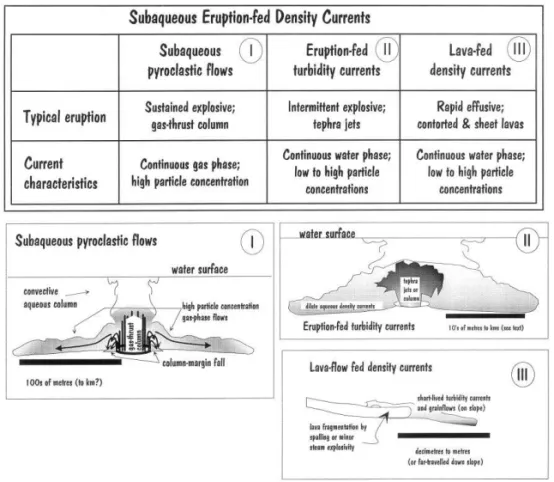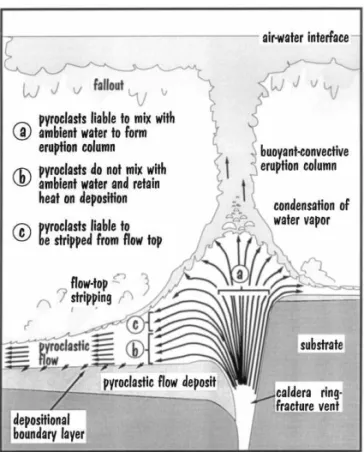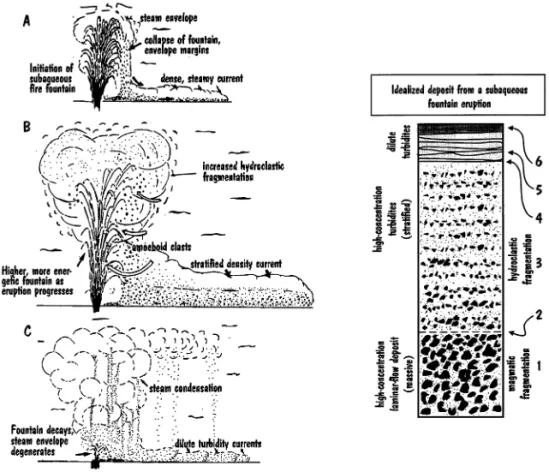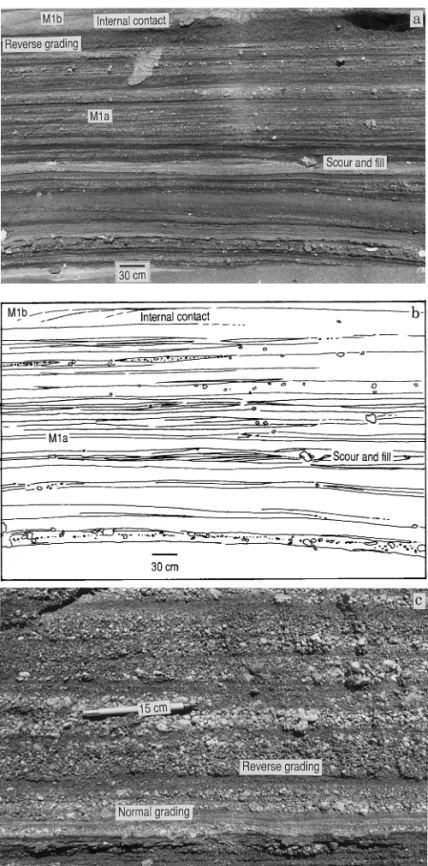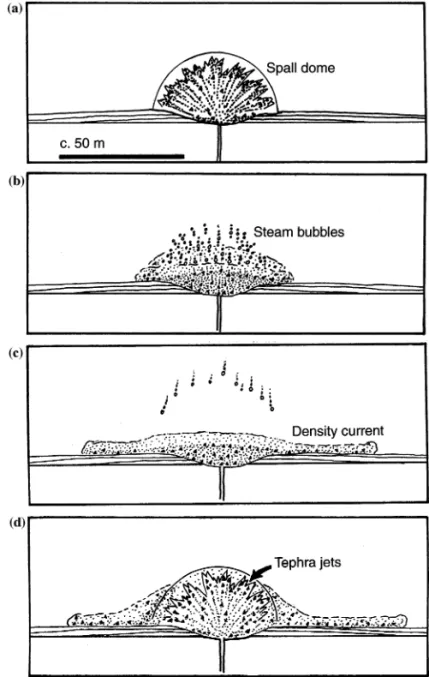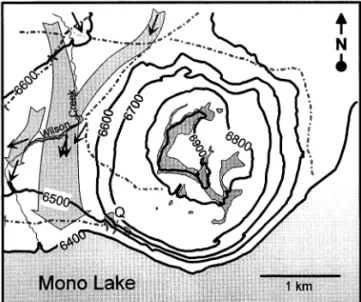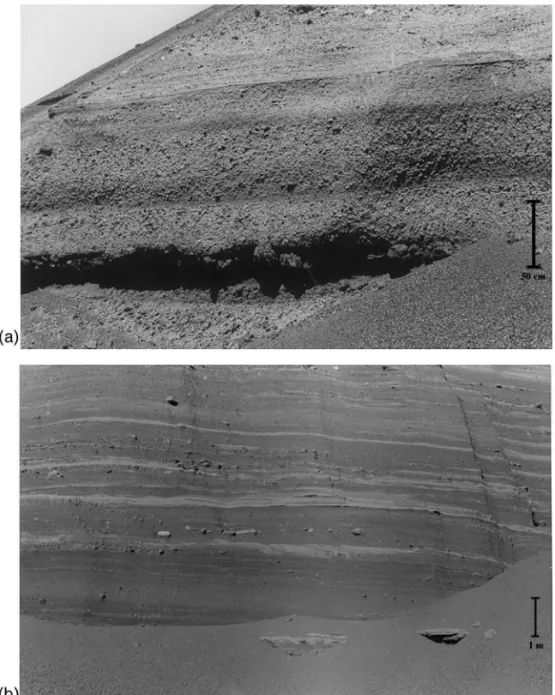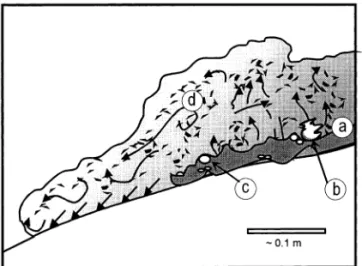Subaqueous eruption-fed density currents and their deposits
James D.L. White
Geology Department,Uni6ersity of Otago,PO Box56,Dunedin,New Zealand
Abstract
Density currents fed directly from subaqueous eruptions can be divided conceptually into three groups based on modes of fragmentation and transport: (I) explosive fragmentation, with deposition from a gas-supported current; (II) explosive fragmentation, with deposition from a water-supported current; (III) fragmentation of flowing lava, with deposition from a water-supported current (Fig. 1). Group I products include subaqueously emplaced welded ignimbrite and other high-temperature emplaced subaqueous pyroclastic flow deposits. Group II products are the most varied, and include representatives of both high- and low-concentration turbidity currents, grainflows and debris flows, and are termed eruption-fed aqueous density currents. Some clasts in such currents are transported and even deposited at high temperature, but the transporting currents, ranging from grain flows to dilute turbidity currents, are water dominated even though steam may be developed along large clasts’ margins. Group III products formed from lava flow-fed density currents tend to be weakly dispersed down-gradient along the seafloor, and generally consist largely of fragments formed by dynamo-thermal quenching and spalling. Bursting of bubbles formed by vapor expansion probably contributes to some Group III beds. Distinctive column-margin fall deposits may form in water-excluded zones that developed very locally around vents in association with Group I and II deposits, and are distinguished by heat retention structures, indicators of gas-phase transport and absence of current-formed deposi-tional features. © 2000 Elsevier Science B.V. All rights reserved.
Keywords:Density currents; Clasts; Seafloor; Pyroelastic fluids; Pyroelastlic density currents; Turbidity current
www.elsevier.com/locate/precamres
1. Introduction
A wide range of deposits consisting entirely of fresh volcanic fragments are formed by sub-aqueous density currents. Density currents bear-ing unmodified eruption-formed fragments originate both directly from volcanic eruptions (pyroclastic flows and surges) and indirectly by remobilization and redeposition of material ini-tially emplaced by a different process (Fisher and
Schmincke, 1984; Cas and Wright, 1987; McPhie et al., 1993). Different researchers apply different terms to redeposited tephra, but for subaerial settings there is agreement that primary pyroclas-tic deposits include all those formed as a result of eruptive fragmentation followed by single-stage transport through the ambient atmosphere. For subaqueous settings, however, even deposits formed by fragmentation followed by uninter-rupted transport through the ambient water column have been commonly termed ‘reworked’ or ‘redeposited’ (Cas and Wright, 1987; McPhie et
E-mail address:[email protected] (J.D.L. White)
al., 1993), despite the absence of any ‘unreworked’ initial deposit. Though subaqueous eruption-fed deposits commonly involve water-supported transport, the transport and depositional pro-cesses are controlled by the nature of the eruption and its interaction with the surrounding water. Eruption-fed deposits should be distinguished wherever possible from genuinely reworked de-posits, which may postdate an eruption by years or centuries, and which can provide far less infor-mation about the subaqueous eruptive process.
The aims of this paper are to review the various types of density currents generated by subaqueous eruptions, to outline the diagnostic features of resulting deposits and in particular those that can be applied to ancient rocks, and to assess the processes linking eruption style to transport and depositional processes.
2. Group I: subaqueous pyroclastic flows
The question of whether pyroclastic flows, which are high-temperature gas-solid flows (Ara-maki, 1957; Aramaki and Yamasaki, 1963; Fisher and Schmincke, 1984), can occur subaqueously has been a contentious one (Sparks et al., 1980; Cas and Wright, 1991 and references therein), but paleomagnetic studies (Kano et al., 1994; Man-deville et al., 1994) and careful documentation of apparent welding textures (Kokelaar and Busby, 1992; Schneider et al., 1992; Fritz and Stillman, 1996; White and McPhie, 1997) continue to bol-ster the case for the process. Subaqueous flow of a gas-supported density current must be driven by the excess density of the current relative to water, and thus requires a very high particle concentra-tion to overcome the low density of the continu-ous gas phase. Pumicecontinu-ous flows must also have a
Fig. 2. (Continued)
vents overlain by tens to hundreds of metres of water develop gas-thrust columns from which wa-ter is excluded (Kokelaar, 1983; Kokelaar and Busby, 1992). The heights of subaqueous gas-thrust columns are considerably suppressed be-cause of the effect of hydrostatic confining pressure upon gas expansion, and pyroclastic flows fed from these suppressed columns are ini-tiated with high particle concentrations. Flow in-teraction with the surrounding water is mediated by stripping of low-particle concentration zones from the top of the flow, and by a transient vapor barrier surrounding the main body of the flow and isolating it from surrounding seawater (Koke-laar and Busby, 1992; Fig. 3). Hydroplaning of high-concentration subaqueous flows (Mohrig et al., 1998) could result in localized, or under some circumstances extensive, disruption of the advanc-ing pyroclastic flow front that may be represented by isolated bodies of tuff (Howells et al., 1985). Alternatively, the low excess densities (Fig. 2) of subaqueously initiated subaqueous pyroclastic flows may slow flow-front advance and inhibit hydroplaning.
Subaqueously erupted and deposited ignimbrite described by Busby-Spera (1986) and Kokelaar and Busby (1992) originally formed a massive,
Fig. 2. High particle concentration is necessary for subaqueous gas-supported flows. The two plots show variation in flow density as a function of pumice-shard ratio (shards are consid-ered non-vesicular glass; glass density 2.5 gm/cm3; gas density 0.01 gm/cm3) plotted against (a) flow voidage (pumice vesicu-larity 70%), and (b) pumice vesicuvesicu-larity, for a flow with a voidage of 0.5 (flow consists by volume of 50% interstitial gas, 50% pumice+shards). Flow voidage (degree of expansion) has a much greater effect on flow density than does pumice vesicularity. The ratio of small non-vesicular shards to pumice is also very important. For instance at a voidage of 40% a mixture containing 70% pumice clasts will have a density of
0.75 gm/cm3 (buoyant), whereas an ash-rich mixture con-sisting of 90% shards has a density of 1.75 gm/cm3. Note that voidage levels greater than0.6 are buoyant even when carrying only dense shards (no vesicles), and thus cannot flow beneath water. Voidage of 0.6 represents a very high-concen-tration current [e.g. fast granular flows (Campbell, 1990) cf. fluidized flows (Wilson, 1980)]: dilute currents commonly have voidage well above 0.999 [0.1% particles; (Freundt, 1998)], and a poorly sorted mixture at rest has voidage of around 0.2 (Nichols et al., 1994).
Fig. 3. Schematic diagram illustrates a subaqueous caldera-forming eruption producing a high-concentration particulate flow having gas as the inter-particle phase (after Kokelaar and Busby, 1992). Such flows form only from high-flux eruptions, and must have high particle concentrations to flow beneath water (Fig. 2).
non- to poorly stratified scoria lapilli tuff of Miocene age in Japan (Kano et al., 1994). Pumice swarms and gas-escape pipes occur locally, the base of the deposit has rip-up clasts and well developed load casts into underlying tuff, and the top of the layer grades into parallel laminated beds of basaltic-andesite tuff. Direct evidence for hot em-placement is provided by non-random thermorem-anant magnetic orientations of scoria clasts. Hot emplacement is also suggested by strong load casting (from boiling of interstitial water in under-lying tuff (Howells et al., 1985) and gas-escape pipes rooted at different levels within the deposit. Subaqueous deposition is supported by fossils in the enclosing sediment and an absence of shallow-water indicators.
There is a gradation between gas-supported and water-supported subaqueous density currents. Gas-supported flows may be transformed to water-sup-ported ones by mixing along the length of a flow (Cas and Wright, 1991; Kokelaar and Busby, 1992). They may also grade with time into water-sup-ported flows as a result of changes in eruption conditions (Mueller and White, 1992; Kano et al., 1996), as will be discussed below in connection with Group II deposits.
2.1. Recognition of Group I deposits
Diagnostic depositional features of subaqueous pyroclastic flows include, in addition to evidence from enclosing beds of continuous subaqueous depositional setting, welding textures, evidence of heat retention such as welding textures (Schneider et al., 1992) and, for younger deposits which have never been recrystallized, poor sorting and massive nature, and clasts with aligned thermoremanent magnetic orientations, together with poor sorting and massive nature (Table 1). Associated features are overlying co-genetic tuffs showing evidence for deposition from turbidity currents and subsequent suspension, and loading induced soft-state defor-mation of underlying sediments. Cold subaqueous pyroclastic flows should not exist because there is no mechanism for cooling the vent-derived intersti-tial gas without either expanding the flow to densities too low to flow beneath water, or ingesting water.
unsorted deposit, up to c. 1 km thick in intra-caldera sites, passing laterally into thinner ign-imbrite layers interstratified with water-settled tuff. Large blocks of country rock are present within the thickest and most massive deposits. Collapsed pumice fiamme form up to 50% of the rock, and visco-plastically deformed glass shards are pseudo-morphically replaced by quartz – feldspar aggre-gates. The suite of deposits represents the subaqueous equivalent of a medium-volume ign-imbrite forming Plinian eruption (Kokelaar and Busby, 1992). Similarly massive, pumiceous de-posits with characteristics of subaerial ignimbrite and paleomagnetic evidence for high-temperature emplacement were deposited subaqueously during the Krakatau eruption (Mandeville et al., 1994).
In studies of ancient rocks, particularly fossil-free deposits of Precambrian age, the existence of pre- and post-ignimbrite marine conditions may be best shown by presence of iron formation, turbidites, or tempestites. Wave indicators offer only ambiguous support because of the possibility of tens of metres of pre-eruption inflation and emergence preceding large silicic eruptions (Or-ton, 1991). Hot but unwelded pyroclastic-flow deposits probably cannot be unambiguously iden-tified in the absence of a reliable paleomagnetic signature.
3. Group II: eruption-fed aqueous density currents
The group of subaqueous flows here grouped as eruption-fed aqueous density currents comprises dilute to high-concentration particulate gravity flows having water as the continuous intergranu-lar phase. Most involve turbulence as a particle support mechanism, though vertical and/or lateral segregation may result in vertically stratified or laterally evolving currents in which parts of the flow are dominated by intergranular collisions and hindered settling. Individual clasts within such flows may remain hot during transport and deposition, but sufficient gas to exclude water from the bulk of the flowing mass is neither generated nor entrained during column collapse.
The classic ‘doubly graded sequences’ of the Tokiwa Formation (Fiske and Matsuda, 1964) are excellent examples of deposits from eruption-fed aqueous density currents as defined here. The deposits are over- and underlain by fossiliferous sub-wavebase marine deposits, and comprise
ex-tensive nonwelded lapilli tuffs and tuff breccias in beds from a few metres to several tens of metres thick. Tuff and lapilli tuff consists of glassy juve-nile clasts ranging in vesicularity from dense to pumiceous, together with crystals of plagioclase and quartz. Fiske and Matsuda (1964) recognized a consistent association of thick, internally un-stratified beds formed of larger clasts graded by fall velocity together with a finer sand-grade inter-stitial ash, overlain by thin, turbiditic beds con-sisting entirely of sand-grade ash. The thin beds show little size grading, but strong density grading marked by upward enrichment in pumice. A thin-ning and fithin-ning upward set of these thin beds, together with the underlying thick and unstratified bed, represents deposits of density flows fed from a single eruption. The authors viewed the eruption as having proceeded from gradual expansion of an eruption column into which water was in-gested, to subsidence and outward flow of the bulk of this material in a water supported ‘pyro-clastic flow’ (Fiske, 1963; Fiske and Matsuda, 1964, p. 84) to form the thick lower bed, to subsequent decay of dilute regions of the aqueous convective column to form a series of increasingly fine-grained and low volume turbidity current de-posits. Water-supported ‘pyroclastic flows’ are terminological hybrids (Cas and Wright, 1991), and can be viewed instead as eruption-fed high-concentration aqueous sediment gravity flows that are either high-concentration turbidity currents and basal layers thereof (Lowe, 1982; Postma et al., 1988; Kneller and Branney, 1995; Sohn, 1997), or cohesionless debris flows or grain flows (Lowe, 1976; Postma, 1986; Nemec, 1990). The eruptions envisaged by Fiske and Matsuda (1964) involved
Table 1
Summary information for subaqueous pyroclastic flow deposits (Group I)
Feature Inference Interpretation
Explosive eruption Fine grainsize Efficient fragmentation
Deposition en masse or by continuous aggradation Deposited from high particle-concentration flow Massive, unsorted
body of deposit from over-capacity current
Matrix welding All fragments deposited hot Passage from vent to depositional site without en-countering water (steam-bordered column and flow) Traction deposition, multiple flows or pulses Deposited from dilute aqueous currents carrying par-Bedded, graded
strong magmatic fragmentation at the vent, but were insufficiently vigorous and sustained to pro-duce ‘true’ pyroclastic flows in which gas formed the continuous interparticle phase. The Tokiwa flows originated as the tephra particles were ‘de-livered’ directly into the water column by eruptive processes. It is inferred here that tephra leaving the condensing or water-entraining margin of the gas-thrust region of the subaqueous eruption column became entrained as a population of dis-crete clasts into initially bouyant heated water, which upon cooling and sediment loading sub-sided and moved away from the vent as moder-ately dense sediment gravity flows. Additional coarse tephra dispersed through the water column may have continuously rained into the flows, sup-pressing any tendency to form distinct thin layer-ing (Lowe, 1988; Arnott and Hand, 1989).
Archean deposits within the Hunter Mine Group represent an important variation in erup-tion-fed aqueous density current sequences, illus-trating the gradational relationship of these flows to gas-supported subaqueous pyroclastic flows. Mueller and White (1992) described a continuous sequence of beds ranging from a massive lower unit in which large juvenile rhyolite clasts show evidence for soft-state deformation upon deposi-tion, stratigraphically upward to thin beds of blocky rhyolite clasts (Fig. 4). A fountaining style of eruption is inferred on the basis of fluidally shaped clasts (Mueller and White, 1992). The ability of the clasts to retain heat during transport to the depositional site indicates isolation from surrounding water. Because fountaining eruptions are typified by efficient separation of particles from expanding volatiles at the vent (Head and Wilson, 1989), the exclusion of water from part of the eruption-fed current is ascribed to generation of steam where outer parts of thea high-concen-tration density current (debris-flow or fast granu-lar flow) dominated by closely-spaced high-temperature clasts encountered and trans-ferred heat to water. This mode of steam genera-tion is attrigenera-tional, because flow-margin clasts are cooled and fragmented in the process of forming the steam which isolates more inward parts of the flow from surrounding water. The non-welded nature of the matrix to the large clasts in the
upper part of the lower unit indicates that the current changed with time. Initially, the steam generated as heat was transferred from the closely spaced particles caused water to be almost entirely displaced from lower parts of the depositing cur-rent. Upwards in the deposit and with time, the current became one in which water was the con-tinuous phase yet in which the larger clasts re-mained insulated by self-generated steam jackets, persisting because of the greater heat content of the large clasts. The eruption itself evolved from a dense suppressed magmatic fountain to a phreatomagmatic eruption in which particle frag-mentation was in part driven by water entering the vent and the pyroclasts were carried upward convectively entrained in an aqueous column (Fig. 4).
Fig. 4. Schematic model (left) of a subaqueous fire-fountain eruption (after Mueller and White, 1992). (A) Erupting fluid magma is torn apart by magmatic gas expansion in the fountain, is largely enclosed within a steam envelope; spatter-like amoeboid clasts are formed. Marginal fountain subsidence produces dense, lateral flows of amoeboid clasts within a steam-rich matrix: these flows produce initially hot deposits in which amoeboid clasts continue to deform, becoming locally pressed together. (B) Fountain becomes more strongly affected by hydrovolcanic processes as the eruption progresses, turbulence at the boundaries of the steam envelope causing increasing ingestion of water into the fountain and increasing turbulence at the margin. Water entering the fountain causes abrupt cooling and hydroclastic fragmentation of the erupting magma in much of the fountain, but parts remain isolated from ingested water and continue to produce amoeboid clasts. Particulate density flows shed from the fountain margins move away from the vent as stratified high-concentration sediment gravity flows. Amoeboid clasts entrained in these flows are preserved against hydroclastic fragmentation by steam generated along the margins of the clasts themselves during transport. Unlike amoeboid clasts deposited from early fountain collapse, these are cooled before deposition and do not weld together. (C) As the eruption wanes and magma volume flux decreases, the fountain progressively condenses and disintegrates, forming a series of increasingly dilute pyroclastic turbidity currents, which deposit a succession of variably thick Bouma turbidites. Remaining fine-grained ash is carried away from the eruption site to form more widespread subaqueous fallout deposits. Simplified stratigraphy (right) of pyroclastic deposits produced by one eruption event. (1) Massive deposit with hot-emplaced amoeboid clasts. (2) Diffuse contact. (3) Matrix-rich and matrix-poor layers with predominantly blocky, hydroclastically fragmented, grains. (4) Sharp contact. (5) Deposits of dilute turbidity currents with low-angle scouring and truncation. (6) Rapid post-eruption suspension deposit (aqueous fall) overlain by iron formation.
particles initially forming the sediment gravity flows represents a critical distinction from other-wise similar flows originating by sediment failure on steep slopes that must evolve from debris flows by ingestion of water (Sohn et al., 1997). Dilute eruption-fed flows likely evolve as waning, deple-tive turbidity currents, and may uniquely lack an initial waxing, accumulative phase (Kneller and
Branney, 1995).
dan, 1983), which increase in development and abundance upward in the mound sequence (Fig. 5d – g and Fig. 7c).
Thin, shallow-dipping tephra beds also make up the subaqueously formed mound-shaped vol-cano of Black Point (Fig. 8), on the shore of
Fig. 5. (Continued)
Mono Lake, California (Christensen and Gilbert, 1964; Custer, 1973; White, 1994). The mound comprises c. 100 m of moderately well sorted coarse ash and lapilli in beds centimeters to deci-meters thick (Fig. 9a – d), generally similar to the mound strata at Pahvant Butte. Exposed beyond the mound is a thin and extensive sheet of fine to medium ash from the eruption which shows per-vasive climbing-ripple cross lamination. Interest-ingly, both the cross-lamination in this ash sheet where exposed west and north of the mound, and local crossbeds in coarse ash and lapilli ash beds of the mound itself, indicate deposition from cur-rents flowing southward. As was recognized by Custer (1973), this direction indicates that glacially-fed bottom currents controlled transport directions; he concluded that ash was delivered by fall from a subaerial ash plume to the water, where it was entrained in the thermal density currents. It is inferred that these bottom currents redirected eruption-fed turbidity currents even during growth of the mound.redistributed downslope into the lake prior to deposition. The subcircular form of the mound is somewhat sur-prising given the apparent vigor of these currents, but this may be in part an artifact of erosion on the lakeward side of the edifice (which would have been the direction of elongation resulting from current redirection) and large-scale slumping to the north. Further work is underway to better understand development of this fascinating volcano.
Eruption-fed aqueous density currents also are inferred to have formed during the historic erup-tion of Myojinsho volcano off the coast of Japan, which has recently been re-analysed by Fiske et al. (1998). Little information is available on the bed-ding style of the volcano’s deposits, but volcano bathymetry shows extremely even, radially sloping flanks that are inferred to have formed from
high-particle concentration gravity flows devel-oped from eruption-fed dense aqueous suspen-sions The steep, c. 20°, slopes of Myojinsho’s flanks (and thus dip of the beds constituting the cone) suggest very inefficient transport, with high-particle-concentration currents moving essentially as aqueous grainflows in which interparticle colli-sion and hindered settling, rather than turbulence,
were the major grain support mechanisms (Ne-mec, 1990). Eruptive activity recorded by the flank deposits took place at shallow levels, with tephra jets venting to the surface. It was material stripped from the subaqueous jet margins and fallback from jets that fed the dense aqueous suspensions which evolved into flank-forming gravity currents. This contrasts with direct injec-tion of tephra jets into the water column, as at Pahvant Butte and Black Point, which much more effectively disperses ejecta into the water and pro-duces dilute eruption-fed aqueous density currents rather than hyperconcentrated ones as indicated for construction of Myojinsho’s cone.
3.1. Recognition of Group II deposits
Deposits of eruption-fed aqueous density cur-rents may show the entire range of sedimentary structures exhibited by grainflow deposits, debris flow deposits, and high- and low-concentration turbidites, so distinguishing eruption-fed se-quences from products of immediately post-erup-tive redeposition may not always be possible. Distinction of current-emplaced beds from sub-aqueous suspension-fall beds can be made on the basis of bed lenticularity, scouring, clast imbrica-tion and cross-stratificaimbrica-tion, none of which will be present in the latter (Table 2). Key features of eruption-fed aqueous density flow deposits in-clude their componentry, which will be entirely derived from the eruption itself. An absence, or minimal amount, of grain abrasion commonly allows preservation of clasts with complex shapes the deposits (Doucet et al., 1994; Fig. 10). Heat retention features may be associated with larger clasts (Mueller et al., 1993), but not with matrix
clasts. Where original morphology can be recon-structed subaqueous edifices will be conrecon-structed largely of eruption-fed deposits, which are the primary deposits of the subaqueous realm. Con-sistent gradation in bedding style through a se-quence of turbidites consisting of unabraded juvenile grains is likely to reflect evolution of an eruption (e.g. BTL 1b of Cousineau, 1994).
Surt-Fig. 8. Paleocurrent pattern of fine-grained eruption-fed den-sity flow deposits at Black Point volcano, Mono Lake, eastern California. Paleocurrent arrows are from Custer (1973) and author’s unpublished data, and are directed down the general paleolakefloor gradient rather than radially outward from the volcano. This pattern results from interaction of glacier-fed thermal underflows with eruption-fed turbidity currents9 fall-out ash settling through the water column (Custer, 1973), and emphasizes different ways of generating eruption-fed sediment-ing density flows, and the importance of any ambient currents in controlling local depositional features.
Fig. 9. The Black Point subaqueous mound strata share the low depositional dips of Pahvant Butte deposits, but exposed strata are less well bedded and lack recognizable combined-flow bedding features (cf. M3). (a) Subhorizontal beds of lapilli ash locally contain lenses of cauliflower bombs at the broadly scoured bases of thick beds. Bedding is defined by thin zones of lapilli-poor medium ash; some beds have reverse-graded bases; larger clasts locally occur isolated near the tops of beds. (b) Illustrated face is orientedN – S at ‘Q’ (Fig. 8), and shows generally parallel bedding with subtle low-angle erosional surfaces, isolated cauliflower bombs and blocks of lake sediment (arrowed). A cross-stratified bed up to 40 cm thick extends across the photo, with foresets dipping to the right-tangential to the mound outline at this site, and downslop toward Mono Lake. (c) Beyond the mound an extensive deposit of fine-medium ash, up to 15 m thick, shows ubiquitous ripple-drift cross-lamination directed generally southward (Fig. 8). Ripple-drift horizons vary from a few cm thick, separated by thin planar beds of coarse ash or, rarely, lapilli, to 50 cm. (d) The lower contact of the ripple-drift unit sharply overlies pre-eruption lacustrine sediment. No lacustrine mud interbeds occur within the unit, and it is overlain by lacustrine sediment above a B1 m thick zone in which a few ash beds are intercalated.
seyan deposits of Bridge Point, New Zealand show an upward change to beds containing abraded clasts and fossils (Cas et al., 1989), and
4. Group III: lava-fed density currents
This group includes turbidity currents and re-lated non-turbulent flows such as grainflows, and grainfalls, which entrain and distribute particles formed and shed along the margins of advancing subaqueous lava flows (Table 3). Fragments are formed along the flow margins by thermal shock granulation, dynamo-thermal spalling or, above the critical depth for seawater (ca. 4200 m), local-ized and variably suppressed steam explosions.
Ongoing fragmentation along the surfaces of ad-vancing lava may result in development of a hyaloclastite carapace, maintained as a granular dispersion expanded by steam or buoyant hot water and jostled and penetrated by the lava. Advance of pillow tubes and buds generates mi-nor fragmental debris, but more complex, rapid and irregular advance of fluidal lavas can result in greater degrees of fragmentation. Entrainment of fragments into density currents is aided by heating of the surrounding water along the flow margins
Table 2
Summary information for eruption-fed aqueous density current deposits (Group II)
Feature Inference Interpretation
Particles fed directly from erupting Homogeneous source, limited transport
Homogeneous particle population,
unabraded or very nearly so; complex vent, in contrast to post-eruptive deposits that may incorporate clasts may be present; large clasts may
other debris, involve interim stage show heat retention features
of particle abrasion, e.g. from waves transport in water, large clasts self-insulated by steam films Variable grainsize, often dominated by Variably effective fragmentation, fines either Often from intermittent eruptions
of Surtseyan or Strombolian style; sorted out or not produced during eruption
lapilli size
fines may be winnowed from convective aqueous columns, margins of tephra jets
Thin to thick bedding, poor to good Non-sustained, multiple currents, sorting Originated by injection of tephra into water column, with nature of prior to current initiation and/or sorting
sorting, may show tractional bedforms
during current transport resulting currents controlled largely by initial suspended concentrations and particle populations
Particles cooled prior to or during No matrix welding Most fragments deposited cold
aqueous transport; large particles may retain heat, but not sufficient to produce gas-phase flow
which generates convecting steam along flow mar-gins and heated water which, as observed by Moore et al. (1973), produces significant rising currents above advancing subaqueous lava flows. These currents can entrain and loft small flow-generated hyaloclastite particles; the coarsest en-trained particles may settle individually to form localized fall deposits. Finer particles are inferred to accumulate in suspension to feed initially verti-cal, low-energy, density currents which subse-quently move downslope along the seafloor. Larger blocks forming as lava fragments on steep slopes commonly slide, roll and saltate downslope as debris falls (Nemec, 1990; Sohn et al., 1997). Conceptually, deposits of lava-fed density cur-rents (LDCs) are distinct from those resulting from entirely post-eruptive redistribution of clasts by failure-generated turbidity currents or other mass flows, though in practice it is typically very difficult to demonstrate unambiguously a directly lava-fed origin.
Basaltic hyaloclastite some 200 m thick in south Iceland is inferred by Bergh and Gudmunder (1991) to have been deposited from lava flow-fed
Table 3
Summary information for lava flow-fed density current deposits (Group III)
Feature Inference Interpretation
Range of fragmentation processes form Lava flows fragment by chilling and Fragment shapes include blocky
stressing, and by local steam (or fragments, platy shards, sometimes the shards; blocky and platy shards from
superheated water?) interactions; little ‘limu’ or hairlike shards; large thermal shock and dynamo-thermal
spalling; ‘limu’ and hairlike shards from
proportions of fine fragments (smaller fine ash produced bursting and spattering of fluid lava
than 4 phi) are uncommon
Weakly normal-graded beds, platy and Deposition according to fall velocity, Deposition from dilute sediment gravity ‘limu’ shards at tops of beds, local with indications of current activity, flows
traction transport weak scouring, imbrication; some beds
may be reverse graded
‘Avalanching’ of debris, as on lava Poor sorting, mixing of clasts formed by
Pillow fragments, parapillows, isolated
pillows with sand-grade matrix (sparse different fragmentation processes delta foresets, steep slopes to supporting)
density currents of both high and low particle concentrations stemming from subaqueous erup-tions at shelfal depths. They envisage a high-flux eruption of basaltic magma that disintegrated upon contact with water into a weakly stratified mixture of fluidal coherent lava, lava rags, and quench-fragmented glass that flowed downslope from the eruption site. Upper parts of this mix-ture moved as a granular flow (aided by hot, buoyant interstitial water) that interacted with the underlying granular flow, and even with penetrat-ing lava apophyses, to form weakly stratified beds with lava stringers. Entrainment of additional wa-ter along the top of the granular flow foswa-tered turbidity currents, the deposits of which consist of well-defined graded beds that gradationally over-lie the weakly stratified underlying hyaloclastite to complete what Bergh and Gudmunder (1991) termed the ‘Standard Depositional Unit’ for this sort of lava-fed hyaloclastite sequence (Fig. 11).
Bedded hyaloclastite occurring as thin sheet-form deposits on modern seamounts has been inferred by Batiza et al. (1984) and Smith and Batiza (1989) to have been deposited by density currents. These deposits consist of beds centime-ters to a couple of decimecentime-ters thick made up of glassy, non-vesicular, sideromelane fragments of two distinct shapes. The bulk of such deposits consists of blocky fracture-bounded grains typical of those formed by quench granulation (Carlisle, 1963) and shattering of thin rigid glass rinds as a result of movement in the fluid lava core
(Koke-laar, 1986). Among these, however, are unusual fluidal fragments of the types referred to as Pele’s hair and Pele’s skin (limu o’ Pele), the latter being most common and occurring as tiny (several mm2)
folded and recurved sheets. A recent re-examina-tion by Batiza et al. (1996) of such deposits on Seamount Six suggests that these hyaloclastite fragments are formed by interaction of exception-ally fluid glassy lava with sediment and water, and that the sheetform bedded hyaloclastite deposits were deposited from lava flow-fed density cur-rents. Details of this process are provided by Maicher (1999), but in outline the process envis-aged involves entrapment of water or water-laden sediment within very thin, fast, flows of fluid lava. The deposits formed at water depths of c. 1800 m, somewhat above the critical depth for seawater, and it is inferred that the entrapped water boiled, expanding by a factor of perhaps 10× to inflate and burst small bubbles that are represented by the limu fragments (Batiza et al., 1998; Maicher, 1998). The ‘limu’ together with blocky fragments simultaneously generated by quenching and dy-namic shattering, arewere collected, entrained and lofted by steam and buoyant hot water along the lava flow, then dispersed locally downslope by weak, dilute density currents (Fig. 12).
frag-mented largely at the leading edge of the delta topset, with the fragments then accumulating as prograding avalanche faces by grainflow, grainfall and turbidity current processes (Nemec, 1990; Porebski and Gradzinski, 1990). Some coherent lava tubes make their way onto the foreset, where
fragmentation continues to generate hyaloclastite, severed lava rags and pillow debris that are car-ried directly downslope by the same processes as outlined for the previous two settings, with finer-grained debris settling locally or being carried in dilute turbulent currents, and coarse blocks trav-elling downslope in debris falls. Additional detail is not presented for this transitionally-subaqueous case here, but extensive studies of lacustrine, glacial and modern settings are available (Fuller, 1931; Swanson, 1967; Jones, 1969; Moore et al., 1973; Skilling, 1994; Werner et al., 1996; Smellie and Hole, 1997).
4.1. Recognition of la6a-fed density current deposits
Where good lateral continuity of exposure ex-ists, the deposits of lava-fed density currents will be clearly associated with simultaneously em-placed lava flows. The flows may be thin and glassy, and often show complex relationships with
Fig. 11.
the hyaloclastite. Deposits of LDCs may include a range of broadly autoclastic fragments including glassy curved splinter shards and blocky shards, parapillows (Walker, 1992), and pillow fragments (Table 3), which may be segregated into coarse debris-fall deposits and finer-grained turbidites and lava-marginal fall deposits. Fine ash is not an important component because few fine-ash grade fragments are formed by autoclasis (McPhie et al., 1993). Fluidal sideromelane fragments are uncom-mon, and where present indicate weakly explosive interaction of fluidal lava flows with ambient or sediment hosted water.
5. Related deposits: column-margin fall
Associated with eruption-fed subaqueous den-sity current deposits beyond the vent area are (a)
‘normal’ sedimentary deposits, either background ones (e.g. pelagic ooze) or those from remobiliza-tion and redeposiremobiliza-tion of tephra from erupremobiliza-tion-fed deposits; (b) aqueous fallout deposits, which may be derived from subaerial or subaqueous eruption plumes, and in some cases; (c) lava flows or shallow intrusions. At the margins of a sub-aqueous vent, an additional type of deposition may take place out of eruption columns from which water is excluded by magmatic volatiles. These deposits form in subaqueous settings within vents or on their margins, yet show no evidence of interaction with water. Kokelaar (1983) termed such water-exclusion zones ‘cupolas’, and de-scribed evidence from Surtla for clast agglutina-tion on impact which he interpreted to support the existence of a water-excluded zone during that entirely subaqueous eruption. One facies at Pah-vant Butte has similarly been interpreted to have formed in a zone of water exclusion on the basis of position near the base of the volcano, local distribution, and presence of impact sags, ar-moured lapilli and accretionary lapilli (White, 1996). In both cases, the phenomenon of water exclusion is inferred to be associated with continuous eruption. Rheomorphically welded ig-nimbrite, similarly inferred to have formed in a water-excluded zone in a rhyolitic vent is discussed by Kano et al. (1997), Schmincke and Bednarz (1990) identify subaqueously formed spatter agglutinate in the deep-water Troodos Ophiolite, and Gill et al. (1990) describe tack-welded scoria from the modern seafloor of the Sumisu Rift. All of these units are inferred to have formed by fallout or very local-ized flow at high depositional rates and particle concentrations, in or at the margins of vents. Although not themselves generally products of subaqueous density currents, study of such de-posits can provide important ancillary informa-tion to reconstruct the evoluinforma-tion of an erupinforma-tion responsible for a suite of density current deposits. Cas and Wright (1991) infer that some rocks interpreted as subaqueously welded ignimbrite are the result of this sort of process, and that they should not be considered pyroclastic flow de-posits.
Table 4
Summary information for column-margin fall deposits formed in water-excluded zones
Feature Inference Interpretation
Diffuse or parallel bedding contacts; local Absence of current during deposition Suspension/fall deposition (no traction features)
normal grading
Ballistic transport in gas (rather than Ballistic impact sags
Local bomb or block sags
liquid) medium
Tachylite or microcrystalline clasts; little Heat retention features, indicative of Pyroclasts not in contact with water or no sideromelane; welded clasts or emplacement at high temperature prior to deposition
matrix with uniform paleomagnetic signature
Local armoured lapilli (and/or core-type Accretion of damp ash to form Transport as dispersed particles in droplet-laden gas; pyroclasts not aggregate grains
accretionary lapilli?)
enclosed in water during particle accretion
5.1. Recognition of column-margin fall deposits
Key indicators of column-margin water-exclu-sion zones are heat-retention features, such as welding and clast agglutination, and accretionary textures such as armoured lapilli (Table 4). Evi-dence of heat retention by small clasts is especially important — larger clasts may evolve their own steam carapaces or exclusion zones because of their relatively great heat content, but small clasts are rapidly chilled and cannot retain significant heat if dispersed in water. Agglutination of clasts or welding of vitric ash are diagnostic, though McPhie and Hunns (1995) offer a cautionary dis-cussion of a tuff welded subaqueously by later hypabyssal intrusion of basalt. Accretionary tex-tures typically form where water vapor facilitates adhesion of small grains, and do not form in the presence of excessive water (Schumacher and Schmincke, 1995), such as where tephra grains are entrained in water. Similarly, well developed block and bomb sags require high impact veloc-ities resulting from ballistic transport, and do not occur where clasts fall to the depositional site through water.
6. Concluding comments
Deposits of eruption-fed subaqueous density currents are likely to be far more common than has been recognized to date. This assertion rests
References
Allen, J.R.L., 1982. Sedimentary Structures. Their Character and Physical Basis. Developments in Sedimentology, 30. Elsevier, Amsterdam, 593 pp.
Aramaki, S., 1957. Classification of pyroclastic flows (in Japanese). J. Volcanol. Soc. Jpn. 1 (series 2), 47 – 57. En-glish Translation (1961), International Geology Review 3, 518 – 524.
Aramaki, S., Yamasaki, M., 1963. Pyroclastic flows in Japan. Bull. Volcanol. 26, 89 – 99.
Arnott, R.W.C., Hand, B.M., 1989. Bedforms, primary struc-tures and grain fabric in the presence of supended sediment rain. J. Sed. Petrol. 59, 1062 – 1069.
Batiza et al., 1996. New evidence from Alvin for the origin of deep-sea eruptive hyaloclastite on Seamount 6, Cocos Plate, 12°43% N. 1995 Fall Meeting Abstracts, EOS, 76: F650.
Batiza, R., Coleman, T., White, J., Pan, Y., 1998. Deep Sea Hyaloclastites: new data from Alvin and laboratory stud-ies. In: Geological Society of America Penrose conference on evolution of ocean islands, Program and Abstracts: 18. Batiza, R., Fornari, D.J., Vanko, D.A., Lonsdale, P., 1984. Craters, caldereas and hyaloclastites on young Pacific seamounts. J. Geophys. Res. 89, 8371 – 8390.
Bergh, S.G., Gudmunder, E.S., 1991. Pleistocene mass-flow deposits of basaltic hyaloclastite on a shallow submarine shelf, South Iceland. Bull. Volcanol. 53, 597 – 611. Bradley, W.H., 1965. Vertical density currents. Science 150,
1423 – 1428.
Branney, M.J., Kokelaar, B.P., 1992. A reappraisal of ign-imbrite emplacement: progressive aggradation and changes from particulate to non-particulate flow during emplace-ment of high-grade ignimbrite. Bull. Volcanol. 54, 504 – 520.
Busby-Spera, C.J., 1986. Depositional features of rhyolitic and andesitic volcaniclastic rocks of the Mineral King sub-marine caldera complex, Sierra Nevada, California. J. Vol-canol. Geotherm. Res. 27, 43 – 76.
Campbell, C.S., 1990. Rapid granular flows. Ann. Rev. Fluid Mech. 22, 57 – 92.
Carey, S.N., Sigurdsson, H., Sparks, R.S.J., 1988. Experimen-tal studies of particle-laden plumes. J. Geophys. Res. 93, 314 – 328.
Carlisle, D., 1963. Pillow breccias and their aquagene tuffs, Quadra Island, British Columbia. J. Geol. 71, 48 – 71. Cas, R.A.F., Landis, C.A., Fordyce, R.E., 1989. A
mono-genetic, Surtla-type, Surtseyan volcano from the Eocene-Oligocene Waiareka-Deborah volcanics, Otago, New Zealand: a model. Bull. Volcanol. 51, 281 – 298.
Cas, R.A.F., Landis, C.A., Kawachi, Y., Fordyce, R.E., 1986. The Eocene-Oligocene Oamaru volcano: an outstanding facies model for surtseyan volcanoes; possible base surges, and the importance of comtemporaneous epiclastic processes.
Cas, R.A.F., Wright, J.V., 1987. Volcanic Successions, Mod-ern and Ancient. Allen and Unwin, London, 528 pp.
Cas, R.A.F., Wright, J.V., 1991. Subaqueous pyroclastic flows and ignimbrites: an assessment. Bull. Volcanol. 53, 357 – 380.
Christensen, M.N., Gilbert, C.M., 1964. Basaltic cone suggest constructional origin of some guyots. Science 143, 240 – 242.
Cousineau, P.A., 1994. Subaqueous pyroclastic deposits in an Ordovician fore-arc basin: An example from the Saint-Vic-tor Formation, Quebec Appalachians, Canada. J. Sed. Res. Section A Sed. Petrol. Proc. 64, 867 – 880.
Custer, S.G., 1973. Stratigraphy and Sedimentation of Black Point Volcano, Mono Basin, California. M.S. Thesis, Uni-versity of California at Berkeley, 114 pp.
Doucet, P., Mueller, W., Chartrand, F., 1994. Archean, deep-marine, volcanic eruptive products associated with the Coniagas massive sulfide deposit, Quebec, Canada. Can. J. Earth Sci. 31, 1569 – 1584.
Druitt, T.H., 1995. Settling behaviour of concentrated disper-sions and some volcanological applications. J. Volcanol. Geotherm. Res. 65, 27 – 39.
Fisher, R.V., Schmincke, H.-U., 1984. Pyroclastic Rocks. Springer-Verlag, Berlin, 472 pp.
Fiske, R.S., 1963. Subaqueous pyroclastic flows in the Ohanapecosh Formation, Washington. Geol. Soc. Am. Bull. 74, 391 – 406.
Fiske, R.S., Matsuda, T., 1964. Submarine equivalents of ash flows in the Tokiwa Formation, Japan. Am. J. Sci. 262, 76 – 106.
Fiske, R.S., Cashman, K.V., Shibata, A., Watanabe, K., 1998. Tephra dispersal from Myojinsho, Japan, during its shal-low submarine eruption of 1952 – 1953. Bull. Volcanol. 59, 262 – 275.
Freundt, A., 1998. The formation of high-grade ignimbrites, I: experiments on high- and low-concentration transport sys-tems containing sticky particles. Bull. Volcanol. 59, 414 – 435.
Freundt, A., Schmincke, H.-U., 1995. Eruption and emplace-ment of a basaltic welded ignimbrite during caldera forma-tion on Gran Canaria. Bull. Volcanol. 56, 640 – 659. Fritz, W.J., Stillman, C.J., 1996. A subaqueous welded tuff
from the Ordovician of County Waterford, Ireland. J. Volcanol. Geotherm. Res. 70, 91 – 106.
Fuller, R.E., 1931. The aqueous chilling of basaltic lava on the Columbia River Plateau. Am. J. Sci. 21, 281 – 300. Gilbert, G.K., 1890. Lake Bonneville. U.S. Geol. Surv. Mon.
1, 1 – 438.
Gill, J., et al., 1990. Explosive deep water basalt in the Sumisu backarc rift. Science 248, 1214 – 1217.
Head, J.W., Wilson, L., 1989. Basaltic pyroclastic eruptions: influence of gas-release patterns and volume fluxes on fountain structure, and the formation of cinder cones, spatter cones, rootless flows, lava ponds and lava flows. J. Volcanol. Geotherm. Res. 37, 261 – 271.
Jones, J.G., 1969. Intraglacial volcanoes of the Laugarvatn region, southwest Iceland. J. Geol. Soc. London 124, 197 – 211.
Kano, K., Orton, G.J., Kano, T., 1994. A hot Miocene subaqueous scoria-flow deposit in the Shimane Peninsula, SW Japan. J. Volcanol. Geotherm. Res. 60, 1 – 14. Kano, K., Yamamoto, T., Ono, K., 1996. Subaqueous
erup-tion and emplacement of the Shinjima Pumice, Shinjima (Moeshima) Island, Kagoshima Bay, SW Japan. J. Vol-canol. Geotherm. Res. 71, 187 – 206.
Kano, K., Matsuura, H., Yamauchi, S., 1997. Miocene rhy-olitic welded tuff infilling a funnel-shaped eruption conduit Shiotani, southeast of Matsue, SW Japan. Bull. Volcanol. 59, 125 – 135.
Kneller, B.C., Branney, M.J., 1995. Sustained high-density turbidity currents and the deposition of thick massive sands. Sedimentology 42, 607 – 616.
Kokelaar, B.P., 1983. The mechanism of Surtseyan volcanism. J. Geol. Soc. Lond. 140, 939 – 944.
Kokelaar, B.P., 1986. Magma – water interactions in sub-aqueous and emergent basaltic volcanism. Bull. Volcanol. 48, 275 – 289.
Kokelaar, B.P., Busby, C.J., 1992. Subaqueous explosive erup-tion and welding of pyroclastic deposits. Science 257, 196 – 201.
Lowe, D.R., 1976. Subaqueous liquified and fluidized sediment flows and their deposits. Sedimentology 23, 285 – 308. Lowe, D.R., 1982. Sediment gravity flows: II. Depositional
models with special reference to the deposits of high-den-sity turbidity currents. J. Sed. Petrol. 52, 279 – 297. Lowe, D.R., 1988. Suspended-load fallout rate as an
indepen-dent variable in the analysis of current structures. Sedimen-tology 35, 765 – 776.
Maicher, D., 1998. Deep-sea ‘limu o’ Pelee’ formation. In: International Volcanological Conference, Cape Town, South Africa, pp. 38.
Maicher, D., 1999. Hyaloclastite beds of shelf and seamount: roles of exsolution, entrapment and entrainment. Unpub-lished PhD dissertation Thesis, University of Otago, Dunedin, New Zealand, 272 pp.
Mandeville, C.W., Carey, S., Sigurdsson, H., King, J., 1994. Paleomagnetic evidence for high-temperature emplacement of the 1883 subaqueous pyroclastic flows from Krakatau Volcano, Indonesia. J. Geophys. Res. 99, 9487 – 9504. McPhie, J., Doyle, M., Allen, R., 1993. Volcanic Textures: a
guide to the interpretation of textures in volcanic rocks. CODES Key Centre, University of Tasmania, Hobart, 198 pp.
McPhie, J., Hunns, S.R., 1995. Secondary welding of sub-marine, pumice-lithic breccia at Mount Chalmers, Queens-land, Australia. Bull. Volcanol. 57, 170 – 178.
Mohrig, D., Whipple, K.X., Hondzo, M., Ellis, C., Parker, G., 1998. Hydroplaning of subaqueous debris flows. Geol. Soc. Am. Bull. 110, 387 – 394.
Moore, J.G., Phillips, R.L., Grigg, R.W., Peterson, D.W., Swanson, D.A., 1973. Flow of lava into the sea 1969 – 1971, Kilauea Volcano, Hawaii. Geol. Soc. Am. Bull. 84, 537 – 546.
Mueller, W., White, J.D.L., 1992. Felsic fire-fountaining be-neath Archean seas: pyroclastic deposits of the 2730 Ma Hunter Mine Group, Quebec, Canada. J. Volcanol. Geotherm. Res. 54, 117 – 134.
Mueller, W., Chown, E.H., Potvin, R., 1993. Substorm wave base felsic hydroclastic deposits in the Archean Lac des Vents volcanic complex, Abitibi belt, Canada. J. Volcanol. Geotherm. Res. 60, 273 – 300.
Nemec, W., 1990. Aspects of sediment movement on steep delta slopes. In: Colella, A., Prior, D.B. (Eds.), Coarse-Grained Deltas. Int. Assoc. Sed. Spec. Pub. 10, 29 – 73. Nichols, R.J., Sparks, R.S.J., Wilson, C.J.N., 1994.
Experi-mental studies of the fluidization of layered sediments and the fromation of fluid escape structures. Sedimentology 41, 233 – 253.
Orton, G.J., 1991. Emergence of subaqueous depositional environments in advance of a major ignibrite eruption, Capel Curig Volcanic Formation, Ordovician, North Wales-an example of regional volcanotectonic uplift? Sed. Geol. 74, 251 – 286.
Porebski, S.J., Gradzinski, R., 1990. Lava-fed Gilbert-type delta in the Polonez Cove Formation (Lower Oligocene), King George Island, West Antarctica. In: Coarse-Grained Deltas. Int. Assoc. Sed. Spec. Pub. 10, 335 – 351. Postma, G., 1986. Classification for sediment gravity-flow
deposits based on flow conditions during sedimentation. Geology 14, 291 – 294.
Postma, G., Nemec, W., Kleinspehn, K.L., 1988. Large float-ing clasts in turbidites: a mechanism for their emplace-ment. Sed. Geol. 58, 47 – 61.
Schmincke, H.-U., Bednarz, U., 1990. Pillow, sheet flow and breccia flow volcanoes and volcano-tectonic hydrothermal cycles in the Extrusive Series of the northeastern Troodos ophiolite (Cyprus). In: Malpas, J., Moores, E.M., Panayiotou, A., Xenophontos, C. (Eds.), Ophiolites, Oceanic Crustal Analogues: proceedings of the Symposium ‘Troodos 1987’. Geological Survey Dept, Ministry of Agri-culture and Natural Resources, Nicosia, Cyprus, pp. 185 – 206.
Schneider, J.-L., Fourquin, C., Paicheler, J.-L., 1992. Two examples of subaqueously welded ash-flow tuffs: the Visean of southern Vosges (France) and the upper Cre-atceous of northern Anatolia (Turkey). J. Volcanol. Geotherm. Res. 49, 365 – 383.
Schumacher, R., Schmincke, H.-U., 1995. Models for the origin of accretionary lapilli. Bull. Volcanol. 56, 626 – 639. Skilling, I.P., 1994. Evolution of an englacial volcano: Brown
Bluff, Antartica. Bull. Volcanol. 56, 573 – 591.
Smellie, J.L., Hole, M.J., 1997. Products and processes in Pliocene-Recent, subaqueous to emergent volcanism in the Antarctic Peninsula: examples of englacial Surtseyan vol-cano construction. Bull. Volvol-canol. 58, 628 – 646.
Smith, T.L., Batiza, R., 1989. New field and laboratory evi-dence for the origin of hyaloclastite flows on seamount summits. Bull. Volcanol. 51, 96 – 114.
Sohn, Y.K., Kim, S.B., Hwang, I.G., Bahk, J.J., Choe, M.Y., Chough, S.K., 1997. Characteristics and depositional pro-cesses of large-scale gravelly Gilbert-type foresets in the Miocene Doumsan fan delta, Pohang Basin, SE Korea. J. Sed. Res. 67, 130 – 141.
Sparks, R.S.J., Sigurdsson, H., Carey, S.N., 1980. The en-trance of pyroclastic flows into the sea, II. Theoretical considerations on subaqueous emplacement and welding. J. Volcanol. Geotherm. Res. 7, 97 – 105.
Swanson, D.A., 1967. Yakima basalt of the Tieton river area, south central Washington. Geol. Soc. Am. Bull. 78, 1077 – 1110.
Thorarinsson, S., 1967. Surtsey. The New Island in the North Atlantic. The Viking Press, New York, 47 pp.
Valentine, G.A., 1987. Stratified flow in pyroclastic surges. Bull. Volcanol. 49, 616 – 630.
Walker, G.P.L., 1992. Morphometric study of pillow-size spec-trum among pillow lavas. Bull. Volcanol. 54, 459 – 474. Werner, R., Schmincke, H.-U., Sigvaldason, G., 1996. A new
model for the evolution of table mountains: volcanological
and petrological evidence from the Herdubreid and Herdu-breidarotgl volcanoes (Iceland). Geol. Rundsch. 85, 390 – 397.
White, J.D.L., 1994. Sublacustrine eruptive processes, Pleis-tocene Lake Russell, California, USA. Abstracts. Geol. Soc. New Zealand Ann. Conf. Geol. Soc NZ Misc. Pub. 80A, 186.
White, J.D.L., 1996. Pre-emergent construction of a lacustrine basaltic volcano, Pahvant Butte, Utah (USA). Bull. Vol-canol. 58, 249 – 262.
White, M.J., McPhie, J., 1997. A submarine welded ign-imbrite-crystal-rich sandstone facies association in the Cambrian Tyndall Group, western Tasmania, Australia. J. Volcanol. Geotherm. Res. 76, 277 – 295.
Wilson, C.J.N., 1980. The role of fluidization in the emplace-ment of pyroclastic flows: an experiemplace-mental approach. J. Volcanol. Geotherm. Res. 8, 231 – 249.
Wohletz, K.H., Sheridan, M.F., 1983. Hydrovolcanic explo-sions II. Evolution of basaltic tuff rings and tuff cones. Am. J. Sci. 283, 384 – 413.
